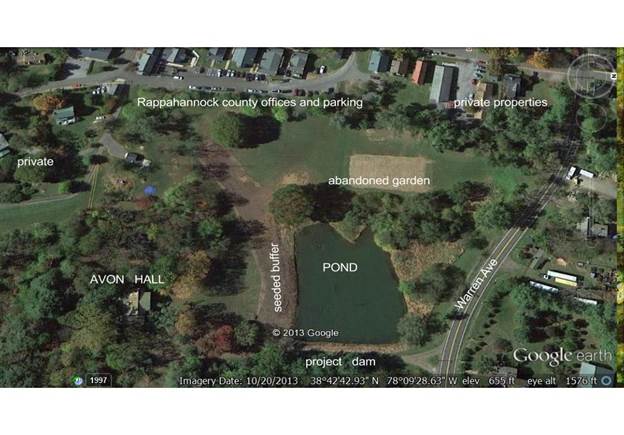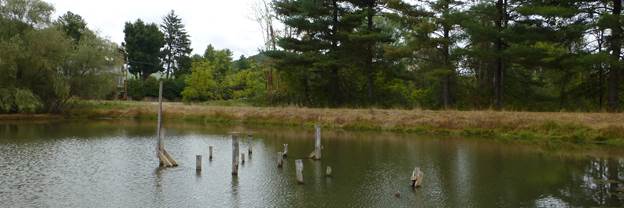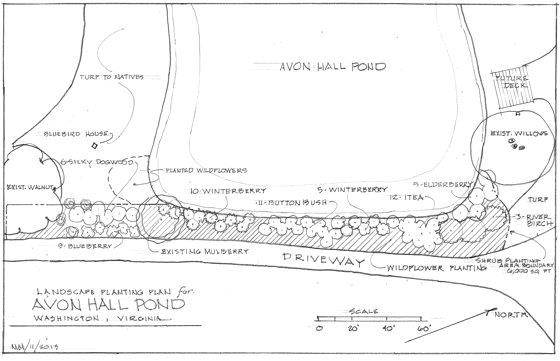How Healthy Are Our Watersheds?
Ways to Protect Our Watersheds
Stream Buffers
-Riparian Buffer & Rain Garden
-Buffer Handbook
-Sources of native plants
Upper Thornton River Watershed Study
RappFLOW is a member of the Orion Grassroots Network
Virginia Trees for Clean Water Program from Virginia Department of Forestry
(Proposal from the Town of Washington and RappFLOW)
The Town of Washington and RappFLOW request grant funds of $3,493.00 to create and maintain a vegetative buffer of native trees, shrubs and forbs that will reduce water pollution, enhance the natural beauty of the site, and educate the public at a highly visible Town property. This effort is part of a larger set of ecological improvement and educational projects on the Avon Hall property. The overall ecological goal is to improve natural ecosystems and thereby improve the water quality of the pond and its drainage into the Rush River, the upper Rappahannock River all in the Chesapeake Bay watershed.
The Avon Hall property is owned by the Town of Washington and the county of Rappahannock, Va. The aerial photo below shows the watershed for the pond, and the adjacent land uses. The outflow from the pond goes to a wetland downstream, and thence to a larger pond across Rt. 211.

The Avon Hall grounds – about 20 acres – are public use areas for sewage treatment plant, watershed protection, education, wildlife habitat, community events, and recreation. RappFLOW and Old Rag Master Naturalists are converting mowed turf to native plants known for their butterfly and birdlife habitat. Trails and a demonstration raingarden are under construction.
In 2008 RappFLOW conducted an analysis of a pond on the property and determined that the pond was very polluted, primarily from the large goose population and acres of mowed turf on hillsides in the small watershed. (We have obtained similar e coli readings in recent months.) Please see http://www.rappflow.org/projects/avon-hall/documents/avon-hall-pond.pdf RappFLOW recommended establishing a vegetative buffer and In 2012 the Town changed the mowing practices on the hillsides to promote better stormwater management. The Town and RappFLOW received a grant through the Culpeper Soil and Water Conservation District to convert some mowed turf to native grasses and forbs. Please see http://www.rappflow.org/projects/avon-hall/documents/Combined_AvonHall_Pond_Plan_RappFLOW2013.pdf for the detailed plan of work. In the spring of 2013 the area was treated and seeded and this Spring it will be seeded with a native wildflower and grasses mix. Some areas are difficult to seed because of springs draining into the pond. Shrubs and water tolerant saplings will be planted at the edge of the pond.
The use of shrubs, grasses and forbes has been the theme of this buffer and landscape project. The use of large trees is kept to a minimum because they would block important views from the road, County buildings, tourists and the mansion. The historic landscape has been turf so the use of lower plants has been the approved theme. This proposed project focuses on the pond dam where trees need to be avoided because of eventual root growth can cause weakening of the structure.
Low shrubs such as buttonbush and silky dogwood saplings (from Va .Dept. of Forestry) will be planted in wet areas where will prosper and eventually produce a ground cover ideal as wildlife habitat with root structure to prevent erosion and the strong rays of the sun drying out the essential moisture. This being public land with the goal of improving natural systems to improve the water quality of the pond and its drainage into the Rush River, the upper Rappahannock River all in the Chesapeake Bay watershed.
The pond dam plus small areas at both ends are proposed to be planted in a landscape concept using potted plants. The area to be planted on the dam is 20’ by 200’.

The pond dam is very visible from Warren Ave. the main entrance to historic Washington, VA. The plants were selected (see landscape plan) to get immediate results in addition to their ecological functions. The slope of mowed turf was treated last fall and is ready for soil preparation and planting this spring. Also included are the areas at each end. Trees were not recommended for the dam because of possible disruption of the dam’s integrity. The landscape proposal includes 3,7and 15 gal. plants to be purchased from local native plant nurseries.
Leaders for the project include a biologist, landscape architect, a grounds maintenance person and an experienced person in organization and volunteer management. Some of the experts and interns who have contributed to this work include: Marc Malik, Landscape Designer; Tim Bondelid, Hydrologist; Ben Estes, Rappahannock High School Intern; Beverly Hunter, President RappFLOW; Helen Hutcheson, Intern from Mary Washington Univ.; Bruce Jones, Advisor and Naturalist; Bryan Lily, Natural Elements LLC; Donna Marquisee, Gardener; Forrest Marquisee, Environmental Scientist; Jonathan Marquisee, PEC Mapping Specialist; Sam Quinn, Biologist, Sunnyside Farm; Dan Spethmann, Washington Town Council and Environmental Scientist; John Sullivan, Mayor of the town; BJ Valentine, Soils Specialist; Virginia Valentine, Biologist; Lou Verner, Aquatic Naturalist, VA DGIF; Greg Wichelns, Culpeper Soil & Water Conservation District.

Qualifications. Projects we have undertaken in the past ten years (including several grant-funded projects with the National Fish & Wildlife Foundation and other local, state and regional government agencies) include public education, water quality monitoring, resource mapping, buffer establishment and rain gardens, as well as watershed analysis and input to public policy. In a project in Sperryville similar to the proposed project, (see http://www.rappflow.org/stream-buffers-2007/PDF/lRappFLOW_lessons_learned_v3.pdf) we conducted the following activities to recruit, train, and coordinate 50 volunteers for assessing creating stream buffers and a rain garden: -defined needed roles for volunteers: project planning and coordination; public outreach; site assessment; site planning; site preparation; planting trees, shrubs and grasses; identifying sources of plant materials. -hired a parttime Volunteer Coordinator to recruit and coordinate volunteers. -recruited volunteers through personal networking at meetings such as Garden Club, Biodiversity Task Force workshops, Master Gardeners and Master Naturalists meetings, RappFLOW meetings, and other community events. -trained volunteers in the field, with the assistance of experts from our partner organizations. - built a database of volunteer contact information and kept records of hours spent on activities.
Long Term Maintenance. Over the years, RappFLOW leaders have discovered through on the ground experience some of the keys to successful maintenance of riparian buffers and rain garden areas that have the characteristics of 1)using native trees, shrubs, forbs, and grasses; 2) depending on volunteers for the work; and 3) use for purpose of public education. The greatest challenge is in minimizing the invasion of exotic species. Secondly, the area needs to be seen as aesthetically pleasing to a wide range of visitors, many of whom are accustomed to seeing mowed turf as attractive. Thirdly, the maintenance needs to be tied closely to the educational program and schedule. There are several reasons for this. The activities of removing invasives are in themselves educational – therefore volunteers need to be scheduled around educational purposes and activities. Also, signage is important so that volunteers can learn the difference between desirable natives and undesirable invasives.
The area is maintained through agreement with Rappahannock County and the Town. In the past, jail trustees have done most of the work but, this year the jail facility will be closed and the labor replaced by a professional maintenance contractor. The area involved in this grant proposal will be included in addition to the rest of the pond buffer. After plant establishment the Town maintenance contractor will take over the full maintenance responsibilities, with consultation provided as needed by RappFLOW.
After planting the area, the volunteers supervised by RappFLOW leaders will water, weed and add mulch for two growing seasons. Any replacement and additions will be coordinated with RappFLOW, the materials provider and the Town. The sapling shrubs in wet areas and along the edge of the pond are expected to grow with little maintenance. The plants selected are known for their ability to grow in very wet conditions as well as short periods of dry conditions. Some hand weeding may be necessary the first year of establishment. A representative from RappFLOW will check and assess the maintenance needs for the first year during the growing season on a weekly basis. If help is needed RappFLOW will provide volunteer assistance. If added material is needed it will be purchased by the Town.
Plant List: Plants: Shrubs:
5-7gal Blueberry, Vaccinium species
11-3gal Buttonbush, Cephalanthus occidentalis
5-3gal Elderberry, Sambucus Canadensis
5-3gal Winterberry, Ilex verticula
12-3gal Va. Sweetspire, Itea virginica
6-3gal Silky Dogwood, Cornus amomu
50 saplings of Buttonbush and 10 Silky Dogwood, to be planted in spring fed wet areas and the edges of the pond (to reduce access by the goose population).
Trees: 3-15gal River Birch, Betula nigra
Wildflowers: Penstemon; Lobellia; Monarda; Baptista australis; Liatrus spicata; Eupatorium; Asclepias; Solidago; Aster; Pycantheum; Panicum; Little Bluestem; Iris (native spec.); Pickerelweed; Carex
Sedges.
NOTE this schedule is subject to change dependent on several variables including date of grant award, weather, and identification of volunteers.
| Month | Task |
Estimated Volunteer Hours |
February |
Develop detailed schedule; order plants; identify and schedule volunteers |
8 + 4 + 8 |
March |
Get soil analysis; prepare area and soil; |
12 + 24 +24 |
April-May |
Plant and mulch saplings, shrubs |
16 + 32 |
|
Plant forbs and grasses |
16 + 12 |
June - August |
Plan public education events; prepare brochures |
10 + 40 |
|
Weed and water as necessary |
48 |
|
Prepare plants for dormancy |
24 |
|
Brief Town Council |
4 |
September |
Conduct public education activities |
40 |
|
Total volunteer & supervision hours |
332 |
|
|
|
